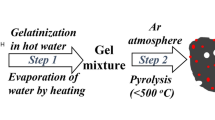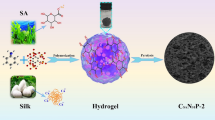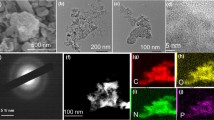Abstract
Pyrogenic biomass carbon has been deemed a promising alternative to Pt/C for the oxygen reduction reaction (ORR) owing to its low cost, excellent activity, and eco-friendly properties. Herein, a porous carbon tube material derived from kapok fibres was prepared by combining activation with pyrolysis. Electrochemical measurements demonstrated that the kapok fibre-derived material prepared at 900°C had excellent ORR performance with a half-wave potential −0.14 V (vs. Ag/AgCl) close to that of commercial Pt/C (−0.13 V vs. Ag/AgCl) in 0.1 mol L−1 KOH. The prepared material also displayed remarkable methanol tolerance and durability. Furthermore, the maximum power density output of the microbial fuel cell using the prepared material was (801±40) mW m−2, comparable to that of the Pt/C cathode ((778±31) mW m−2). The present work provides a facile way of using economical and renewable biomass to develop a porous structure and high-activity cathode ORR catalyst for fuel cell applications.
Similar content being viewed by others
References
Guo S, Zhang S, Sun S. Tuning nanoparticle catalysis for the oxygen reduction reaction. Angew Chem Int Ed, 2013, 52: 8526–8544
Guo D, Shibuya R, Akiba C, et al. Active sites of nitrogen-doped carbon materials for oxygen reduction reaction clarified using model catalysts. Science, 2016, 351: 361–365
Li Y, Gong M, Liang Y, et al. Advanced zinc-air batteries based on high-performance hybrid electrocatalysts. Nat Commun, 2013, 4: 1805
Zheng B, Wang J, Wang F B, et al. Low-loading cobalt coupled with nitrogen-doped porous graphene as excellent electrocatalyst for oxygen reduction reaction. J Mater Chem A, 2014, 2: 9079–9084
Choi C H, Kwon H C, Yook S, et al. Hydrogen peroxide synthesis via enhanced two-electron oxygen reduction pathway on carbon-coated Pt surface. J Phys Chem C, 2014, 118: 30063–30070
Zhang X, Lu P, Zhang C, et al. Towards understanding ORR activity and electron-transfer pathway of M-Nx/C electro-catalyst in acidic media. J Catal, 2017, 356: 229–236
Liu X W, Li W W, Yu H Q. Cathodic catalysts in bioelectrochemical systems for energy recovery from wastewater. Chem Soc Rev, 2014, 43: 7718–7745
Xiong W, Du F, Liu Y, et al. 3-D carbon nanotube structures used as high performance catalyst for oxygen reduction reaction. J Am Chem Soc, 2010, 132: 15839–15841
Wu G, More K L, Xu P, et al. A carbon-nanotube-supported graphenerich non-precious metal oxygen reduction catalyst with enhanced performance durability. Chem Commun, 2013, 49: 3291–3293
Gong K, Du F, Xia Z, et al. Nitrogen-doped carbon nanotube arrays with high electrocatalytic activity for oxygen reduction. Science, 2009, 323: 760–764
Li Y, Zhou W, Wang H, et al. An oxygen reduction electrocatalyst based on carbon nanotube-graphene complexes. Nat Nanotech, 2012, 7: 394–400
Fu P, Zhou L, Sun L, et al. Nitrogen-doped porous activated carbon derived from cocoon silk as a highly efficient metal-free electro-catalyst for the oxygen reduction reaction. RSC Adv, 2017, 7: 13383–13389
Zhou L, Fu P, Wen D, et al. Self-constructed carbon nanoparticles-coated porous biocarbon from plant moss as advanced oxygen reduction catalysts. Appl Catal B-Environ, 2016, 181: 635–643
Bhange S N, Unni S M, Kurungot S. Nitrogen and sulphur co-doped crumbled graphene for the oxygen reduction reaction with improved activity and stability in acidic medium. J Mater Chem A, 2016, 4: 6014–6020
Neaţu F, Trandafir M M, Marcu M, et al. Potential application of Ni and Co stabilized zirconia as oxygen reduction reaction catalyst. Catal Commun, 2017, 93: 37–42
Zhou L, Yang C, Wen J, et al. Soft-template assisted synthesis of Fe/N-doped hollow carbon nanospheres as advanced electrocatalysts for the oxygen reduction reaction in microbial fuel cells. J Mater Chem A, 2017, 5: 19343–19350
Lee S, Kwak D H, Han S B, et al. Synthesis of hollow carbon nanostructures as a non-precious catalyst for oxygen reduction reaction. Electrochim Acta, 2016, 191: 805–812
Liu L, Yin Y X, Li J Y, et al. Free-standing hollow carbon fibers as high-capacity containers for stable lithium metal anodes. Joule, 2017, 1: 563–575
Guan B Y, Yu L, Lou X W D. Formation of single-holed cobalt/N-doped carbon hollow particles with enhanced electrocatalytic activity toward oxygen reduction reaction in alkaline media. Adv Sci, 2017, 4: 1700247
Wang Y, Kong A, Chen X, et al. Efficient oxygen electroreduction: Hierarchical porous Fe-N-doped hollow carbon nanoshells. ACS Catal, 2015, 5: 3887–3893
Chabot V, Higgins D, Yu A, et al. A review of graphene and graphene oxide sponge: Material synthesis and applications to energy and the environment. Energy Environ Sci, 2014, 7: 1564–1596
Borghei M, Lehtonen J, Liu L, et al. Advanced biomass-derived electrocatalysts for the oxygen reduction reaction. Adv Mater, 2017, 30: 1703691
Niu J, Shao R, Liang J, et al. Biomass-derived mesopore-dominant porous carbons with large specific surface area and high defect density as high performance electrode materials for Li-ion batteries and supercapacitors. Nano Energy, 2017, 36: 322–330
Si Y, Chen M, Wu L. Syntheses and biomedical applications of hollow micro-/nano-spheres with large-through-holes. Chem Soc Rev, 2015, 45: 690–714
Yuan Y, Zhou S, Zhuang L. Polypyrrole/carbon black composite as a novel oxygen reduction catalyst for microbial fuel cells. J Power Sources, 2010, 195: 3490–3493
Deng L, Yuan Y, Zhang Y, et al. Alfalfa leaf-derived porous heteroatom-doped carbon materials as efficient cathodic catalysts in microbial fuel cells. ACS Sustain Chem Eng, 2017, 5: 9766–9773
Deng L, Yuan H, Cai X, et al. Honeycomb-like hierarchical carbon derived from livestock sewage sludge as oxygen reduction reaction catalysts in microbial fuel cells. Int J Hydrogen Energy, 2016, 41: 22328–22336
Yuan H, Deng L, Cai X, et al. Nitrogen-doped carbon sheets derived from chitin as non-metal bifunctional electrocatalysts for oxygen reduction and evolution. RSC Adv, 2015, 5: 56121–56129
Yuan Y, Yuan T, Wang D, et al. Sewage sludge biochar as an efficient catalyst for oxygen reduction reaction in an microbial fuel cell. Bioresour Tech, 2013, 144: 115–120
Shen W, Hu T, Wang P, et al. Hollow porous carbon fiber from cotton with nitrogen doping. ChemPlusChem, 2014, 79: 284–289
Zhu H, Wang H, Li Y, et al. Lightweight, conductive hollow fibers from nature as sustainable electrode materials for microbial energy harvesting. Nano Energy, 2014, 10: 268–276
Cao Y, Xie L, Sun G, et al. Hollow carbon microtubes from kapok fiber: Structural evolution and energy storage performance. Sustain Energy Fuels, 2018, 2: 455–465
Caturla F, Molina-Sabio M, Rodríguez-Reinoso F. Preparation of activated carbon by chemical activation with ZnCl2. Carbon, 1991, 29: 999–1007
Liu J, Wang S, Yang J, et al. ZnCl2 activated electrospun carbon nanofiber for capacitive desalination. Desalination, 2014, 344: 446–453
Yang S, Zhi L, Tang K, et al. Efficient synthesis of heteroatom (N or S)-doped graphene based on ultrathin graphene oxide-porous silica sheets for oxygen reduction reactions. Adv Funct Mater, 2012, 22: 3634–3640
Yu H, Shang L, Bian T, et al. Nitrogen-doped porous carbon nanosheets templated from g-C3N4 as metal-free electrocatalysts for efficient oxygen reduction reaction. Adv Mater, 2016, 28: 5080–5086
Tang J, Chen S, Yuan Y, et al. In situ formation of graphene layers on graphite surfaces for efficient anodes of microbial fuel cells. Biosens Bioelectron, 2015, 71: 387–395
Yang X, Zou W, Su Y, et al. Activated nitrogen-doped carbon nanofibers with hierarchical pore as efficient oxygen reduction reaction catalyst for microbial fuel cells. J Power Sources, 2014, 266: 36–42
Li Z Q, Lu C J, Xia Z P, et al. X-ray diffraction patterns of graphite and turbostratic carbon. Carbon, 2007, 45: 1686–1695
Turneaure S J, Sharma S M, Volz T J, et al. Transformation of shock-compressed graphite to hexagonal diamond in nanoseconds. Sci Adv, 2017, 3: eaao3561
Claesson P M, Wal A V D, Fogden A. New Techniques for Optimization of Particulate Cleaning. Handbook for Cleaning/decontamination of Surfaces. 2007. 885–927
Scardamaglia M, Aleman B, Amati M, et al. Nitrogen implantation of suspended graphene flakes: Annealing effects and selectivity of sp2 nitrogen species. Carbon, 2014, 73: 371–381
Tian X, Sun X, Jiang Z, et al. Exploration of the active center structure of nitrogen-doped graphene to control over the growth of Co3O4 for high-performance supercapacitor. ACS Appl Mater Interfaces, 2018, 1: 143–153
Datsyuk V, Kalyva M, Papagelis K, et al. Chemical oxidation of multiwalled carbon nanotubes. Carbon, 2008, 46: 833–840
Tang J, Yuan Y, Liu T, et al. High-capacity carbon-coated titanium dioxide core-shell nanoparticles modified three dimensional anodes for improved energy output in microbial fuel cells. J Power Sources, 2015, 274: 170–176
Acknowledgments
This work was supported by the Postdoctoral Fund of China (Grant No. 2017M622042), the Fujian Provincial Department of Science and Technology of China (Grant No. 2017N0007), the National Natural Science Foundation of China (Grant No. 41601241), and the Key Research & Developement Plan of Fujian Province (Grant No. 2017NZ0001-1). We also thank postdoctoral researcher YUAN HaiJing and Dr. RENSING Christopher at Fujian Agriculture and Forestry University for revising the manuscript.
Author information
Authors and Affiliations
Corresponding author
Additional information
Supporting Information
The supporting information is available online at tech.scichina.com and link.springer.com. The supporting materials are published as submitted, without typesetting or editing. The responsibility for scientific accuracy and content remains entirely with the authors.
Electronic supplementary material
Rights and permissions
About this article
Cite this article
Tang, J., Wang, Y., Zhao, W. et al. Porous hollow carbon tube derived from kapok fibres as efficient metal-free oxygen reduction catalysts. Sci. China Technol. Sci. 62, 1710–1718 (2019). https://doi.org/10.1007/s11431-018-9453-0
Received:
Accepted:
Published:
Issue Date:
DOI: https://doi.org/10.1007/s11431-018-9453-0




